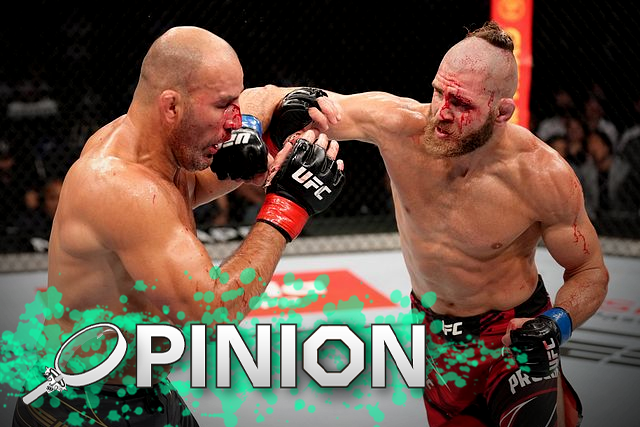Opinion: Jiri Prochazka, A Real-Life Anime Character

Editor’s note: The views and opinions expressed below are those of the author and do not necessarily reflect the views of Sherdog.com, its affiliates and sponsors or its parent company, Evolve Media.
Most mixed martial artists come from pedestrian backgrounds. Despite Dana White’s Contender Series trying to give most of its contestants a weepy backstory, the reality is often far more banal. While most fighters have a chip on their shoulder, their life circumstances are usually middle-class and typical, including their paths as martial artists.
Advertisement
Let’s begin with his early life. Prochazka grew up in the Czech Republic, a country well-known for its female tennis legends—beginning with Martina Navratilova—but with no history or representation in the martial arts. In his teens, Prochazka was a street fighter, a big guy who simply loved brawling. Lacking direction, he was given a book by a coach that would change his life. That tome was “The Book of the Five Rings,” by Musashi Miyamoto, the most legendary of all Japanese samurai, a writing that is a masterpiece of warfare and tactics.
Musashi’s text not only transformed Prochazka’s perspective on
combat but the rest of his life, as well. Dubbing himself the
“Czech Samurai,” Prochazka was guided by the bushido code, a system
of morality and philosophy for the Japanese warrior caste. It all
might have been ridiculous if not for the results. Joining the
premiere Japanese organization
Rizin Fighting Federation, Prochazka blossomed into a
devastating, fearsome champion. He brutally knocked out many famous
names with power that was both shocking and uncanny. Yet, as with
any good anime, there were still new horizons and even tougher
opponents to conquer.
Prochazka entered the Ultimate Fighting Championship amid much skepticism. Hardcore fans dismissed the Czech as a hype job who had built a reputation on washed-up has-beens. Thus, he made his UFC debut as a small underdog against fellow knockout artist Volkan Oezdemir. In an absolutely insane display, the modern-day samurai conducted most of the fight with his hands down against his powerful counterpart. Only a lunatic or anime protagonist would have done something so suicidal. What was the result? A hellacious knockout that left Oezdemir asleep on the canvas for the first and only time in his career.
In his next assignment, Prochazka faced Dominick Reyes, a superlative fighter who most people felt, myself included, defeated Jon Jones for the light heavyweight title. Prochazka introduced his new hairstyle—a samurai-inspired top knot—for this fight. Again, how can a new look that symbolizes greater power be anything but pure anime? Of course, Prochazka won a dazzling showdown, despite being frequently hurt himself.
What is Glover Teixera but the final rival of an anime arc? The Brazilian champion was the old, wise, martial arts master with indomitable fighting spirit and decades of experience that Prochazka had yearned to be. I don’t need to tell you much about their fight at UFC 275; it would be too ridiculous and on the nose even for most anime. Prochazka was badly dominated and at risk of having the fight stopped multiple times. Then, with less than 30 seconds left until he tasted defeat, Prochazka submitted the vastly superior grappler. It was the first submission loss of Teixera’s storied career and the striker Prochazka’s first such victory since 2014—before he had even joined Rizin.
One may well ask why the UFC hasn’t promoted its new superstar as a fictional legend come to life? As I’ve noted before, the organization is hopeless at promoting new talent. It has a straightforward, bland, assembly-line production for promotional videos and posters—notice they all look exactly the same—from which they never deviate. A singular figure like Prochazka doesn’t fit in to the UFC’s mass-produced template. It’s a huge missed opportunity, but perhaps the UFC prefers it that way, as Prochazka won’t become too big of a star and call his own shots, like Jones and more recently Francis Ngannou.
Lastly, I’m sure many will scoff at this article as silly and childish. They would rather MMA be treated as a serious by-the-numbers sport and nothing else. To those I would say that they are missing the most alluring part of combat sports: its romanticism. This is especially easy for me to notice. My many detailed technical articles analyzing every aspect of a fighter’s style receive limited feedback, while my broader articles about the romantic parts of the sport arouse far more attention.
If you don’t believe that, consider a cheesy 1980s martial arts movie called “Bloodsport,” supposedly based on Frank Dux’s real-life exploits. Dux is a laughable fraud who claimed to have fought dozens of times in an imaginary tournament to the death that spanned a couple of days and would appear on trashy 1990s talk shows sporting an eye-patch and claiming to have killed countless men for the United States government. The one time anyone actually saw Dux fight, he was getting his rear end kicked by UFC 1 loser Zane Frazier for not paying a debt.
The movie itself is as stereotypical as it gets, starring Jean-Claude Van Damme as the titular protagonist facing all manner of goofy combatants. Yet, not only was the movie a big hit, but it inspired an entire generation of great martial artists and mere enthusiasts, including yours truly. Brazilian great Rafael dos Anjos uses the “Bloodsport” theme as his walkout track, and a certain French-Canadian was inspired to go into martial arts after watching it. If such a silly movie sparked the imagination of what would become arguably the greatest fighter ever, we can all appreciate the storybook grandeur of Prochazka and his anime journey in the martial arts world.
More




 UFC News & Features
UFC News & Features

